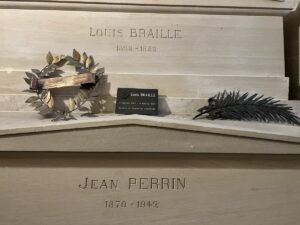It is crazy to think that four weeks have already passed, only leaving us one more week in Paris. With still so many places to explore, I am not ready to say goodbye yet. However, yesterday, Wednesday, June 15th, I had the opportunity to check an item off of my bucket list when our class visited the Pantheon. As I was living very close to this monument during the first three weeks of the trip, I was very excited to finally be able to go inside. The Pantheon, originally built to be used as a church and modeled after the Roman Pantheon, features very tall ceilings with paintings that date back to the nineteenth century. In the center of the main floor is Foucault’s Pendulum, which was, unfortunately, being cleaned during our visit, so we weren’t able to see its full swing.

After exploring the ground floor, we delved into the basement to visit the Pantheon crypt. Prior to the visit, I had a few stops that I wanted to make, such as the tomb of Marie Curie as she was the first woman to be buried in the Pantheon. However, while looking around, I was surprised to find that Louis Braille had been buried there as well. He was publicly recognized by the French government due to his creation of the Braille alphabetic writing system, which greatly contributed to the blind and visually impaired communities around the world, and his remains were taken to the Pantheon in 1952.

There are around six million blind people around the world using Braille, stressing the importance of doing more research on it. Reich, Szwed, Cohen, & Amedi 2011 explored the areas of the brain that could potentially play the role of the visual word form area (VWFA) in people with visual impairment. They recruited eight congenitally blind individuals to partake in multiple different experimental conditions: braille words, braille nonsense words, verb generation, and verb generation control. Their participant results and associated functional magnetic resonance images (fMRI) were compared to data from Cohen et al., 2004 to highlight that visual word form area activation occurred almost identically in visually impaired individuals and sighted, suggesting a “specialization for reading regardless of visual experience”. It is fascinating to learn that the contributions of one man, Louis Braille, have allowed visually impaired individuals to read, even though reading is typically thought of as a unique visual experience.
References:
Reich, L., Szwed, M., Cohen, L., & Amedi, A. (2011). A Ventral Visual Stream Reading Center Independent of Visual Experience. Current Biology, 21(5), 363–368. https://doi.org/10.1016/j.cub.2011.01.040
Cohen, L., Jobert, A., Le Bihan, D., & Dehaene, S. (2004). Distinct unimodal and multimodal regions for word processing in the left temporal cortex. NeuroImage, 23(4), 1256–1270. https://doi.org/10.1016/j.neuroimage.2004.07.052
